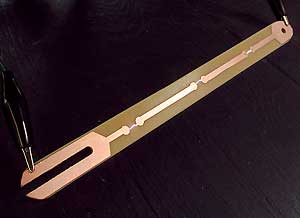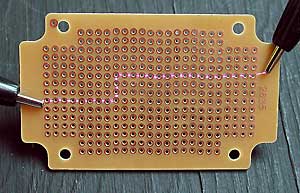I generally feel that the number of spark gaps that are used will have different effects depending on the size of the gun.
As a real world example, you dont use fine grain gun powder in a large-bore gun, just as you dont use rifle powder in a 9mm bullet. The larger bore guns use slower burning powder to make sure the bullet doesnt slow down because the powder finishes burning before it leaves the barrel.
In a large spudgun, a single gap may be more efficeint than 2 or more, while a mini may benifit from 4 gaps.
There really is no hard evidence either way unfortunately.
Crazy Differences
-
SpudBlaster15
- First Sergeant 3


- Posts: 2400
- Joined: Wed Oct 18, 2006 11:12 pm
- Has thanked: 2 times
- Been thanked: 10 times
Lorem ipsum dolor sit amet, consectetur adipiscing elit. Cras nec placerat erat. Vivamus dapibus egestas nunc, at eleifend neque. Suspendisse potenti. Sed dictum lacus eu nisl pretium vehicula. Ut faucibus hendrerit nisi. Integer ultricies orci eu ultrices malesuada. Fusce id mauris risus. Suspendisse finibus ligula et nisl rutrum efficitur. Vestibulum posuere erat pellentesque ornare venenatis. Integer commodo fermentum tortor in pharetra. Proin scelerisque consectetur posuere. Vestibulum molestie augue ac nibh feugiat scelerisque. Sed aliquet a nunc in mattis.
Last edited by SpudBlaster15 on Wed Jul 14, 2021 3:46 pm, edited 1 time in total.
That is flawed logic my friend. Let me expose it for you...jimmy101 wrote: Could be. But has anyone ever observed it to be not true?
Let's suppose I think that farting into a potato gun is better than metered propane for launching spuds the fastest or furthest. I can also concoct some rationale having something to do with Methane having a higher flame speed blah blah blah. Then you ask me to back up my claim with evidence, and preferably chrony data. So I turn around and say...but has anyone ever observed it to NOT be true?
So back to multiple sparks and placement. Someone needs to show that multiple centered sparks improve performance before we accept it as the absolute "truth". Because.....if I claim a single spark at the rear of a combustion chamber is the best, then can you tell me if anyone has observer it to NOT be true?
Good! Because I was flamed for saying it too, and I'm 99% sure you and manObrass took me to task in the process! It was well over a year ago, but regardless I'm happy to see a smart person who agrees with me on this general idea. Better late than never!I'm not sure I follow your point about oversized chamber and burst disk. I believe I have always said<sup>*</sup> that a grossly oversized chamber is a bad thing in a combustion gun. ("grossly oversized" being C:B >1.5 or 2). I too have been flamed for saying that.
Oh, and I didn't say anything about a burst disk in this topic. That was someone else.
- jimmy101
- Sergeant Major 2


- Posts: 3209
- Joined: Wed Mar 28, 2007 9:48 am
- Location: Greenwood, Indiana
- Has thanked: 6 times
- Been thanked: 18 times
- Contact:
This is fun!
Spudblaster15: Could you post a drawing of your spark strip? I'm having trouble envisioning exactly what you did. My default "brain picture" for a spark gap is basically what Latke did (http://www.burntlatke.com/strip.html).
 or
or 
A fairly wide piece of plastic with several spark gaps placed relatively close together, mounted on the wall of the chamber.
You said "The barrel length was left alone." So if you changed the chamber volume but left the barrel alone. What was the C:B ratio of the two guns? Can the difference in performance be explained as resulting form a larger chamber and a better C:B ratio?
"The fuel's burn rate as a function of heat and pressure is (for the most part) fixed," That is basically true but irrelevant. The burn rate is a function of the temp and pressure. But the temperature and pressure as a function of time is dependent on the size of a chamber. A small closed chamber burns faster than a larger one even though both chambers will reach the same final temp and pressure (ignoring differences in the rate of heat loss to the chamber). A small gun's chamber burns faster than a larger gun's chamber. Usually the large chamber has a larger barrel, hence the importance of C:B ratio.
Aturner: No that is not flawed logic. It is merely stating that not only has no one ever proven it wrong, no one has ever even TRIED to measure the affect. I agree that it would be flawed logic if I said "AAA is true" and regardless of (insert link to reasonable well conducted study that proves AAA is false) I still think it is true until someone shows, in all cases, that it is not true.
If you can point to a single chrony study comparing one central spark to several well separated sparks and show that there is little or no change in performance then, and only then, would the "advantage of multiple sparks" be disproven. The fact that no one has attempted to measure the affect can hardly be used to disprove the hypothesis.
I still don't recall flaming you for "oversize chamber decreases performance". I found <a href="http://www.spudfiles.com/spudtech_archi ... rt=0">this post</a> at the SpudTech archives. I posted once in the six pages of the discussion but didn't say anything about the hypothesis. I just suggested an alternative way of optimizing the C:B for a particular gun. I'm not sure of exactly what to search for in the SpudTech forums so I may have missed something.
Spudblaster15: Could you post a drawing of your spark strip? I'm having trouble envisioning exactly what you did. My default "brain picture" for a spark gap is basically what Latke did (http://www.burntlatke.com/strip.html).
 or
or 
A fairly wide piece of plastic with several spark gaps placed relatively close together, mounted on the wall of the chamber.
You said "The barrel length was left alone." So if you changed the chamber volume but left the barrel alone. What was the C:B ratio of the two guns? Can the difference in performance be explained as resulting form a larger chamber and a better C:B ratio?
"The fuel's burn rate as a function of heat and pressure is (for the most part) fixed," That is basically true but irrelevant. The burn rate is a function of the temp and pressure. But the temperature and pressure as a function of time is dependent on the size of a chamber. A small closed chamber burns faster than a larger one even though both chambers will reach the same final temp and pressure (ignoring differences in the rate of heat loss to the chamber). A small gun's chamber burns faster than a larger gun's chamber. Usually the large chamber has a larger barrel, hence the importance of C:B ratio.
Aturner: No that is not flawed logic. It is merely stating that not only has no one ever proven it wrong, no one has ever even TRIED to measure the affect. I agree that it would be flawed logic if I said "AAA is true" and regardless of (insert link to reasonable well conducted study that proves AAA is false) I still think it is true until someone shows, in all cases, that it is not true.
If you can point to a single chrony study comparing one central spark to several well separated sparks and show that there is little or no change in performance then, and only then, would the "advantage of multiple sparks" be disproven. The fact that no one has attempted to measure the affect can hardly be used to disprove the hypothesis.
I still don't recall flaming you for "oversize chamber decreases performance". I found <a href="http://www.spudfiles.com/spudtech_archi ... rt=0">this post</a> at the SpudTech archives. I posted once in the six pages of the discussion but didn't say anything about the hypothesis. I just suggested an alternative way of optimizing the C:B for a particular gun. I'm not sure of exactly what to search for in the SpudTech forums so I may have missed something.

-
SpudBlaster15
- First Sergeant 3


- Posts: 2400
- Joined: Wed Oct 18, 2006 11:12 pm
- Has thanked: 2 times
- Been thanked: 10 times
Lorem ipsum dolor sit amet, consectetur adipiscing elit. Cras nec placerat erat. Vivamus dapibus egestas nunc, at eleifend neque. Suspendisse potenti. Sed dictum lacus eu nisl pretium vehicula. Ut faucibus hendrerit nisi. Integer ultricies orci eu ultrices malesuada. Fusce id mauris risus. Suspendisse finibus ligula et nisl rutrum efficitur. Vestibulum posuere erat pellentesque ornare venenatis. Integer commodo fermentum tortor in pharetra. Proin scelerisque consectetur posuere. Vestibulum molestie augue ac nibh feugiat scelerisque. Sed aliquet a nunc in mattis.
Last edited by SpudBlaster15 on Wed Jul 14, 2021 3:46 pm, edited 1 time in total.
- jimmy101
- Sergeant Major 2


- Posts: 3209
- Joined: Wed Mar 28, 2007 9:48 am
- Location: Greenwood, Indiana
- Has thanked: 6 times
- Been thanked: 18 times
- Contact:
So for the early part of the burn the flame fronts are hemispherical, not spherical. Once the front propagates far enough then it will start to "wrap around" the plastic to the back side of the strip.SpudBlaster15 wrote:My spark strip was similar to the one in the first photo, but it was mounted on the end of two 2.5" long screws threaded into the chamber, effectively placing it in the center, rather than against the wall.
Not the same as a spark strip along the wall, not the same as a standard gap in the center. Be a real PITA to model.
I wonder if there would be much of a difference if the spark strip had gaps on both sides of the plastic? You would get nearly spherical "fronts" when you consider the flame front from the top and the bottom of the strip together.




